Programmatic Digital-Out-Of-Home (pDOOH) can target audiences with personalized and dynamic advertising content while on the go.
Douwe Egberts, a coffee brand, put facial recognition kiosks with cameras in the O.R. Tambo International Airport. If a person yawned in front of the camera, they received a free, freshly brewed cup of coffee.
Like something out of Black Mirror, these examples highlight the potential (and present reality) of the pDOOH advertising industry.
In this article, we review what pDOOH is, how it works, and offer a few examples of pDOOH’s potential in digital programmatic advertising.
First, What is Digital-Out-Of-Home (DOOH) Advertising?
DOOH (digital out-of-home) advertising employs dynamic digital displays to promote products and services to people in public spaces or outdoor environments.
With DOOH, you can reach audiences in high-traffic areas like
- Airports
- Shopping malls
- While driving
You’re probably used to traditional OOH, which uses static visual signage like printed vinyl billboards or posters.
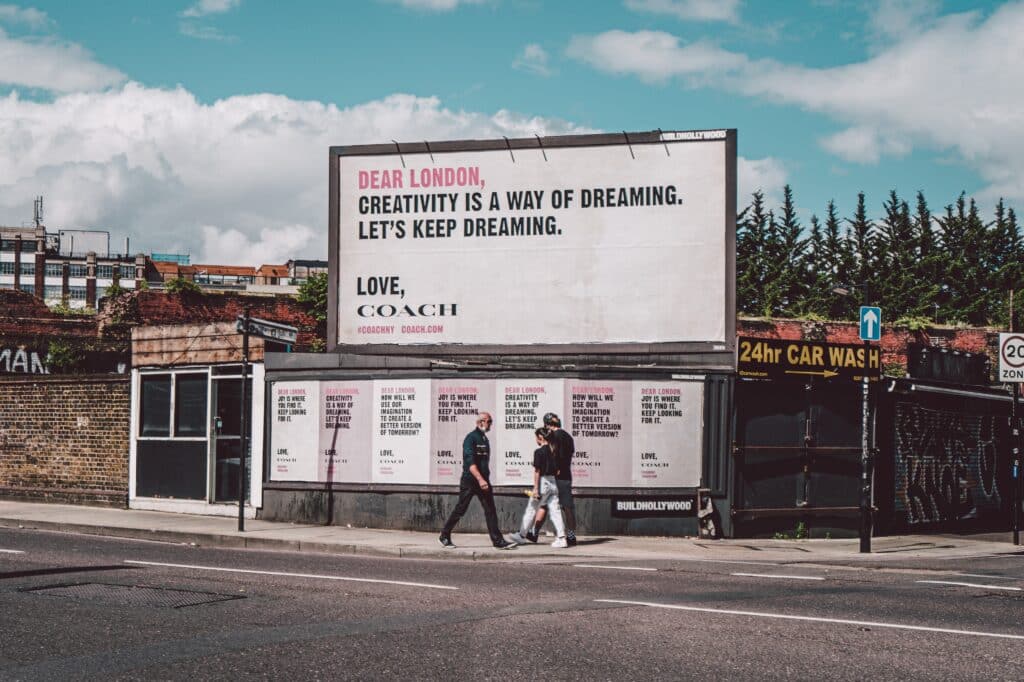
An example of a vinyl billboard.
Digital Out-Of-Home takes traditional OOH and digitizes the experience. For example, while walking down Times Square, you’ll see dozens of bright supersigns, constantly changing the ads displayed on the screen. These are DOOH ads.
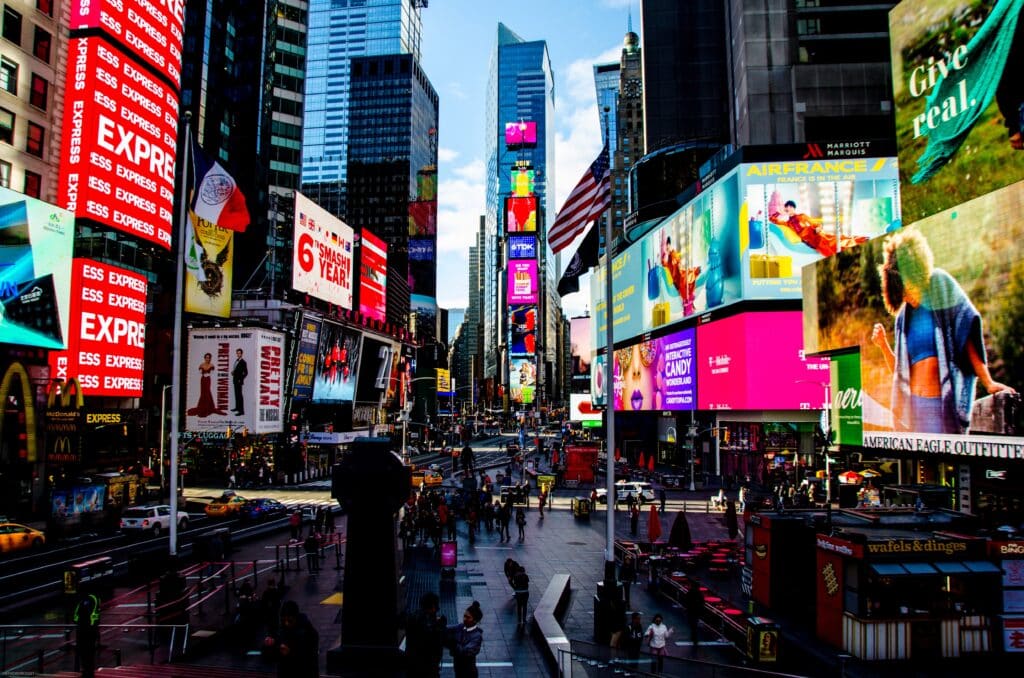
Times Square is a DOOH playground with dozens of digital display ads.
The shift to digital signage opened the door to limitless possibilities like hyper-personalized ads, larger audience reach, and, with the advent of programmatic Digital Out-Of-Home, automated and near-instant ad purchasing.
DOOH has made it possible to reach people wherever they are.
What is Programmatic Digital Out-Of-Home Advertising (pDOOH)?
While regular DOOH is a form of advertising, programmatic DOOH is a way of buying the digital advertising for advertisers and publishers.
Before pDOOH, buying ad space on billboards was a time-consuming process with many middlemen. OOH also lacked metrics tracking for advertising companies to manage campaign success.
With programmatic technology, advertisers can use auction technology software (Demand-Side Platforms (DSPs) to purchase ads (usually using real-time bidding technology).
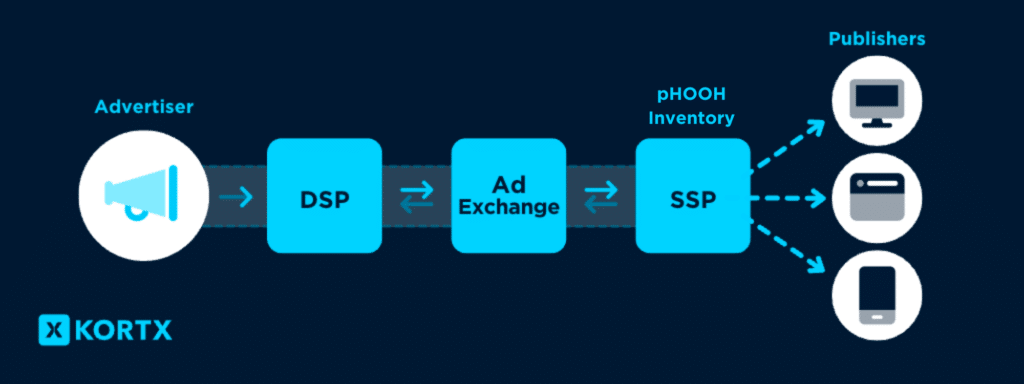
How Programmatic DOOH (pDOOH) Works
Buyers set specific conditions on the display ads like how often, when, and where the ads will appear, and when the software finds ad spaces meeting those conditions, it purchases the space automatically.
Example: Programmatic Buying in Automotive Advertising
- A car manufacturer wants to advertise a new car model.
- An advertiser will use a DSP to set parameters like venue type (office, restaurant, bar, convenience store, and billboards).
- Once the advertiser sets the parameters, the DSP will wait until the conditions set are met.
- Once the conditions are met, the DSP purchases the ad space automatically.
- The ad will display wherever the advertiser specified.
- Once the ads display, advertisers can track them based on impressions (the number of times people see your ads).
How Advertisers Measure the Effectiveness of Programmatic DOOH Campaigns
Impressions are the most accurate measurement of a campaign’s success unless you’re running a foot-traffic study or something similar because advertisers can estimate the potential reach of the DOOH ad campaign.
Ad Impressions vs Plays
A frequent DOOH misunderstanding is what impressions are versus ad plays. Impressions refer to the number of times an ad has been displayed to users, while ad plays refer to the number of times an ad has been viewed, heard, or interacted with by a user.
An ad play is a form of engagement, whereas an ad impression is a display of an ad, whether or not the user actually sees it.
Advertisers track impression count through MAIDs (mobile advertising identifications), unique identifiers assigned to mobile devices used by mobile advertising platforms to track and target advertisements to specific users.
MAIDs are created by the operating system of the device, such as Apple’s IDFA (Identifier for Advertisers) or Google’s AAID (Android Advertising ID), and are stored on the device.
Advertisers use mobile device IDs to track user data, such as their interests, behavior, and preferences, to show them relevant ads.
When a user interacts with an advertisement, the MAID is sent to the advertiser, allowing them to track the effectiveness of the ad and personalize future advertisements for the user.

An example of how MAIDs work. Any time a person passes by your ad and sees it, this counts as an ad impression.
Users can reset or opt out of tracking through their device’s settings, which generates a new MAID for the personal device and blocks advertisers from accessing the previous MAID’s data.
📺 The viewability measurement is another popular method to measure a campaign’s effectiveness. Viewability measures whether a viewer actually sees an ad.
The Types of Programmatic Digital Out-Of-Home Ads You Can Buy
There are five ways to buy pDOOH advertising:
- Open Real-Time Bidding (RTB): buyers automatically place bids on an open ad slot. Then, the system assigns the slot to the highest and most relevant bid and delivers the ad given the specified parameters.
- Private Deal Real-Time Bidding (RTB): similar to open real-time bidding, instead of competing against all buyers for ad space, they bid against a virtual “VIP” room of first-look buyers.
- Programmatic direct: buyers meet with sellers to strike a deal.
- Programmatic guaranteed: buyers agree to buy any ad slots the seller offers that meet their specifications.
- Non-programmatic guaranteed: a manual ad insertion process where buyers must negotiate prices and plan the insertion order (IO) with sellers.
Open Real-Time Bidding (RTB) is the most popular way to purchase pDOOH because it automates the buying process and enables more precise targeting and ad distribution. It’s also highly accessible because buyers don’t need any relationship with the ad sellers to place bids.
With the automation and accessibility of Open Real-Time Bidding, programmatic Digital Out-Of-Home not only offers a new way of advertising but also opens up a world of benefits for both advertisers and consumers.
💻 📊 😌
Find your customers wherever they are.
With access to over 350,000 audience segments and powerful First-Party data, we’ll help you reach every customer and prospect with our programmatic Digital-Out-Of-Home services.
The 6 Benefits of Programmatic DOOH Ads
98% of consumers visited a DOOH venue type in the last 30 days, and 69% of viewers took action after seeing a digital streel-level ad. Actions like searching for an advertiser online, visiting a business in person, or posting about the ad on social.
DOOH By The Numbers:
- 52% of consumers notice digital billboards.
- 57% of them immediately visited the business after viewing the ad.
- 93% of those visiting the business made purchases.
- DOOH advertising spending is expected to grow by 19.2% in 2023.
- In 2020, there were 9600 digital billboards in the United States.
It doesn’t take much to see that programmatic Digital Out-Of-Home works. Like really works, with the ability to set up campaigns in minutes.
Let’s review some other programmatic DOOH capabilities and benefits.
1. Programmatic DOOH increases audience reach.
An Out-Of-Home Advertising Association of America report revealed that over 55% of consumers in big cities notice more OOH signage and around 34% say OOH influences their purchase decisions.
The survey also found that consumers notice OOH the most while driving on highways and locally around the city while walking around downtown, at the airport, and while using public transportation.
Programmatic DOOH uses geospatial analysis to better understand audience movement patterns throughout the day so you can reach them at multiple touchpoints.
Example: Based on data analysis, pDOOH identifies high audience traffic at a morning train station and an afternoon shopping mall, leading the advertiser to buy programmatic inventory like video DOOH ads at these locations for multi-touchpoint audience reach and increased brand exposure.
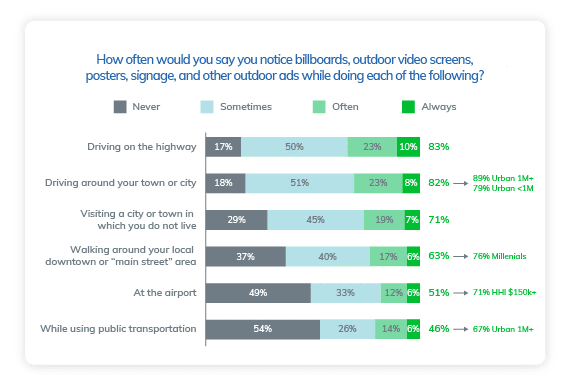
A graph showing how people interact with DOOH advertising.
With its ability to capture consumers while on the go, pDOOH advertising can reach a large and diverse audience, increasing its impact and reach.
2. Programmatic DOOH is easier to purchase.
Gone are the days when programmatic buyers needed to build relationships with ad sellers. Programmatic platforms mean advertisers can purchase and manage programmatic DOOH advertising campaigns efficiently by automating the buying process and enabling more precise targeting and ad distribution through RTB (real-time bidding).
The RTB process occurs in less than a second. That means if an advertiser sets campaign parameters, that ad can be shown almost immediately.
How does programmatic advertising speed up the purchase process with DOOH?
“Efficiency, flexibility, and scale. The efficiency to easily access multiple inventory sources; the flexibility to quickly adjust the spend, creative, and placement types on the fly; and the scale to serve ads on as few or as many placement types that align with the campaign objective.”

3. Programmatic DOOH personalizes the ad experience.
pDOOH offers data-driven behavioral targeting where marketers can define custom audiences and reach them based on where they are and where they’ve been.
Through mobile ad IDS (MAIDs), heat maps, and camera sensors, marketers can use massive volumes of geo-temporal data to understand where audiences are and how they move throughout the day.
Using DSPs, advertisers can activate DOOH ad inventory to target customers in specific locations with a high device concentration that meets certain criteria.
Sometimes advertisers can also use contextual data on weather, travel patterns like traffic, and other events to respond in real-time and adapt appropriate strategies.
Example: If Patagonia is trying to promote its new line of rain boots, they can set weather triggers to play on freeway billboards when it’s raining. Customers would be more likely to purchase rain boots when they see an ad when it’s raining outside rather than when it’s a beautiful sunny day.
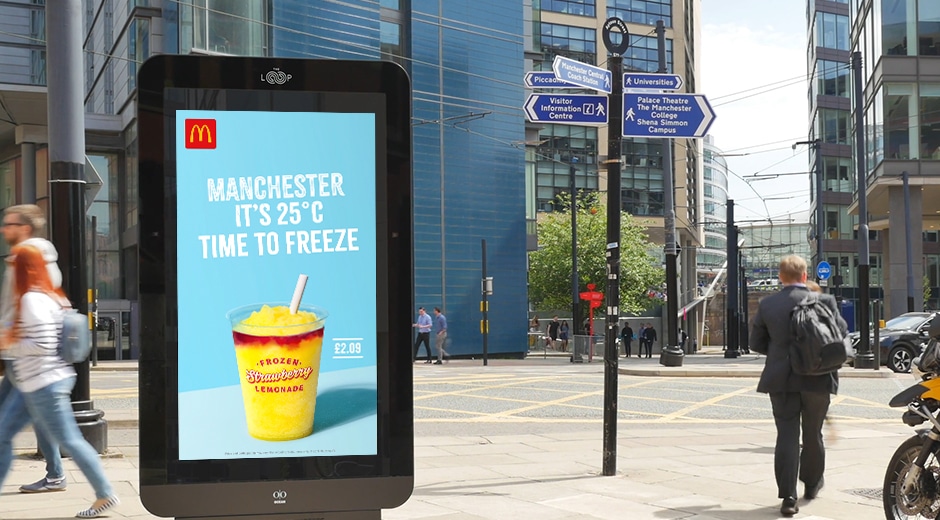
When it was 25 degrees Celsius (77 degrees Fahrenheit), McDonald’s took the opportunity to market its frozen strawberry lemonade.
4. Programmatic DOOH helps you tell a holistic brand story.
With programmatic DOOH, advertisers can create an ad sequence that tells a story over time. By strategically planning and sequencing the content through various high-traffic advertising channels, they can guide audiences through a narrative arc and build engagement.
Example: Imagine a beverage company called “RefreshCo.” To build brand awareness for its new line of organic drinks, they decide to strategically place its ads throughout a consumer’s day like this:
🚗 Morning rush hour: RefreshCo purchases digital screens at public transportation hubs. Commuters waiting for buses or trains see their ads, piquing their interest in a healthy drink to kickstart their day.
🍕 Lunch break: They target screens in popular malls and office buildings near food courts. Their vibrant ads appeal to individuals seeking a refreshing and nourishing option during their lunch break.
🛒 Evening grocery shopping: They secure a grocery TV in supermarkets near the beverage aisle, encouraging consumers to add RefreshCo’s products to their shopping carts.
RefreshCo could also combine programmatic DOOH with mobile retargeting, called device ID passback to maximize exposure. Consumers who have seen their DOOH ads are retargeted with mobile ads, reinforcing the brand message and encouraging them to try RefreshCo’s drinks.
Each ad can serve as a chapter in the brand story, gradually revealing different aspects and creating a more complete brand advertising experience.
5. Programmatic DOOH integrates First-Party data.
In addition to Third-Party data targeting, with pDOOH, you can activate First-Party data to create and target the right audiences at the right time.
At KORTX, we use Axon Audience Manager to provide a comprehensive audience analysis and segmentation. With Axon, users can leverage over one billion user profiles and consumer behavior data from across the internet to create custom audience segments and deliver personalized messaging across digital channels.
Example: Using Axon Audience Manager, a retail brand can use its audience insights to target those who have previously made purchases. With this segment, the brand can deliver personalized ads across various digital channels, such as online advertising and paid social, to re-engage these customers with tailored messaging and promotions.
Combining First-Party data and pDOOH allows you to optimize your advertising efforts by reaching the most relevant audience segments.
6. Programmatic DOOH is for any advertising budget.
The best benefit of pDOOH is selecting ad spaces that fit any business’s budget.
Usually, small businesses are scared to use DOOH because putting a billboard up is prohibitively expensive (upwards of $15,000/month expensive).
With programmatic, we can select digital screens that fit within any budget, catering to small or local businesses to get them the exposure they deserve.
What Are Examples of Programmatic Digital Out-Of-Home Advertising In The Wild?
In this section, we’ll look at some of the most common examples of pDOOH advertising, including dynamic content like interactive kiosks, digital billboards, and elevator ads.
1. Google’s Search and Maps: Digital Billboard Ads
Typically located in high-traffic areas like highways, busy intersections, and shopping centers, digital billboards capture the attention of drivers.
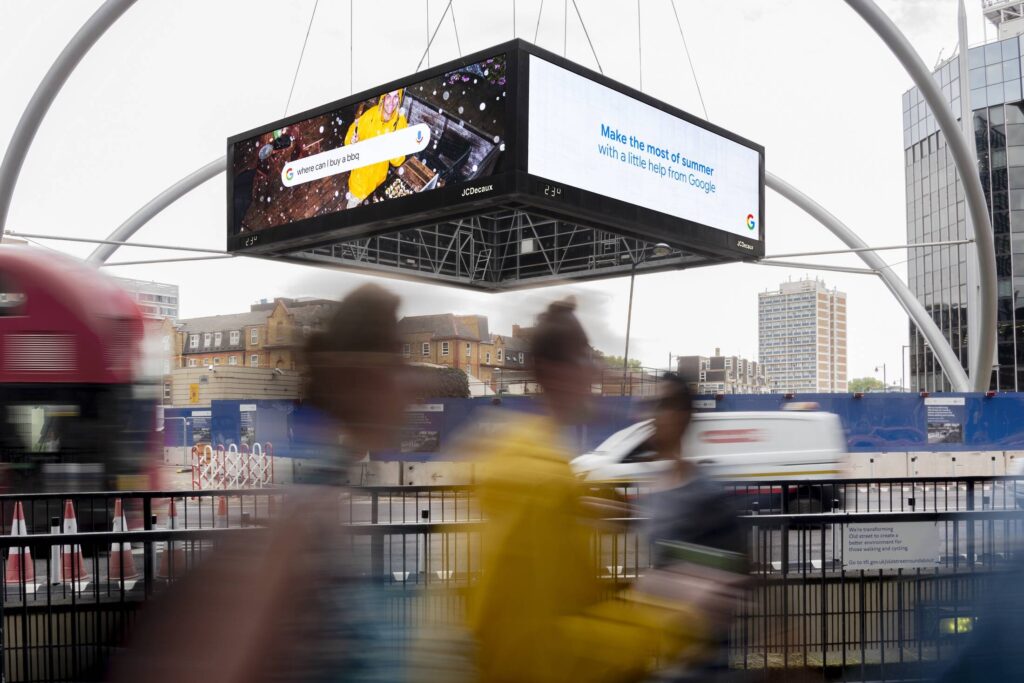
A digital display ad for Google’s “Make the Most of Summer” campaign.
Google used responsive DOOH advertising centered around summertime in the UK in its “Make the Most of Summer” campaign.
Google went the extra mile by hyper-personalizing the experience for customers across London, Manchester, and Birmingham. Dynamic, full-motion DOOH screens featured results for local search terms, business hours of popular restaurants, star ratings, and map directions.
2. ONroute Canada: Interactive Kiosk Ads
Interactive kiosks allow people to interact with content using touchscreens around public places like shopping malls, grocery stores, convenience stores, airports, and city sidewalks.
Ontario, Canada added free-standing, triple-sided kiosks to 20 of 23 ONroute Service Centres for travelers to find places to eat, things to do, and view important road safety information.
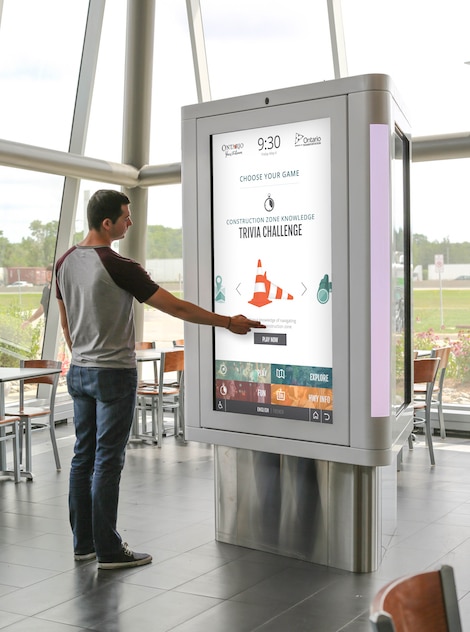
The ONroute Service Center kiosks feature interactive games to entice visitors to visit various Ontario attractions.
Since its launch, the kiosks captured over 190,000 visitors’ attention in the ONroute Service Centers.
What are some of your suggestions for picking DOOH placement locations?
“A multitude of factors all play a role in the decision-making process: the advertiser, geo, campaign objective, budget, and creative. Start with the geo to see what placement types are available. Next, ensure the creative (static image vs. video) aligns with both the available placement types and the overall campaign objective. For example, if the creative has a QR code to illicit a user response, it wouldn’t make sense to run on billboards alongside the highway.”

3. Zara: Elevator Ads
Elevator ads capture people’s attention as they ride the elevator, whether going up one floor or twenty. Advertisers can also use real-time data to adjust the ads based on time of day, location, and audience demographics.
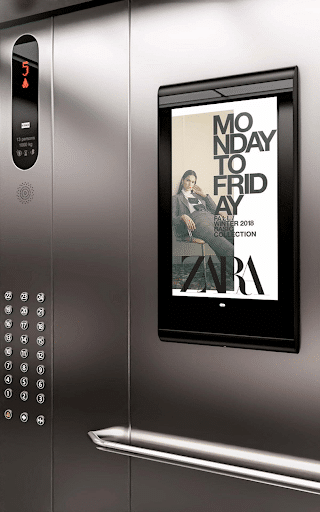
Zara used an elevator ad to capture riders’ attention for its Winter 2016 basic collection, specifically targeting professional women likely to ride elevators in professional office buildings.
4. Carhartt: Weather Trigger Ads
Weather trigger ads dynamically adjust content based on real-time weather conditions.
Carhartt, a local Michigan clothing brand, used rain-triggered ads for its “We’ve Got Your Back 24/7” ad.
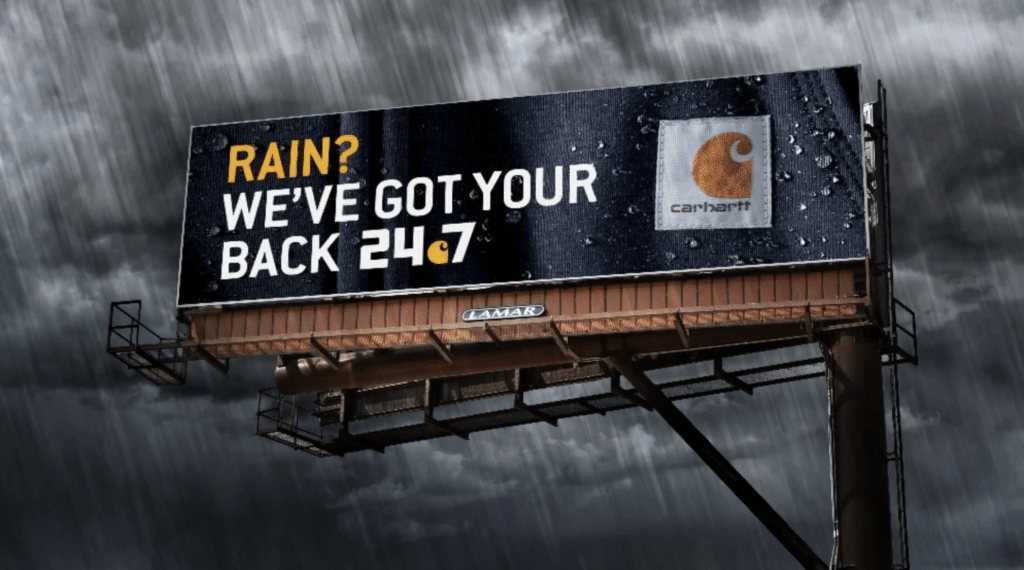
Carhartt showcased its clothing’s practicality and durability during inclement weather, resonating with customers’ needs and demonstrating its reliability.
5. Wanderlust Hard Seltzer: Uber and Gym Ads
DOOH ads can target customers wherever they are: at the gym, walking on the sidewalk, or taking an Uber with place-based screens.
Wanderlust, a popular hard seltzer brand, delivered its ad through multiple advertising channels around New York and Long Island, including Uber and Taxi OOH, urban display screens, and gyms close to 7-Eleven locations to drive audiences.
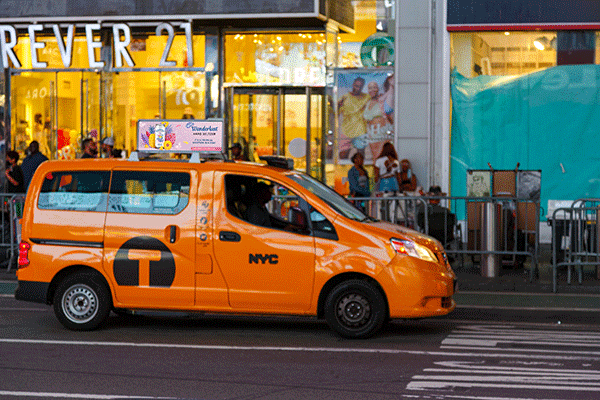
Audiences exposed to the pDOOH ads were also sent mobile ads for an omnichannel experience, resulting in over 17 million publisher impressions and 27% in 7-Eleven store visits.
6. Kylie Skin: Shopping Mall Ads
Shopping mall DOOH ads engage and influence consumers during their shopping experience.
Kylie Jenner used digital billboards and shopping mall screens nationwide to promote the launch of Kylie Skin, her skincare brand.
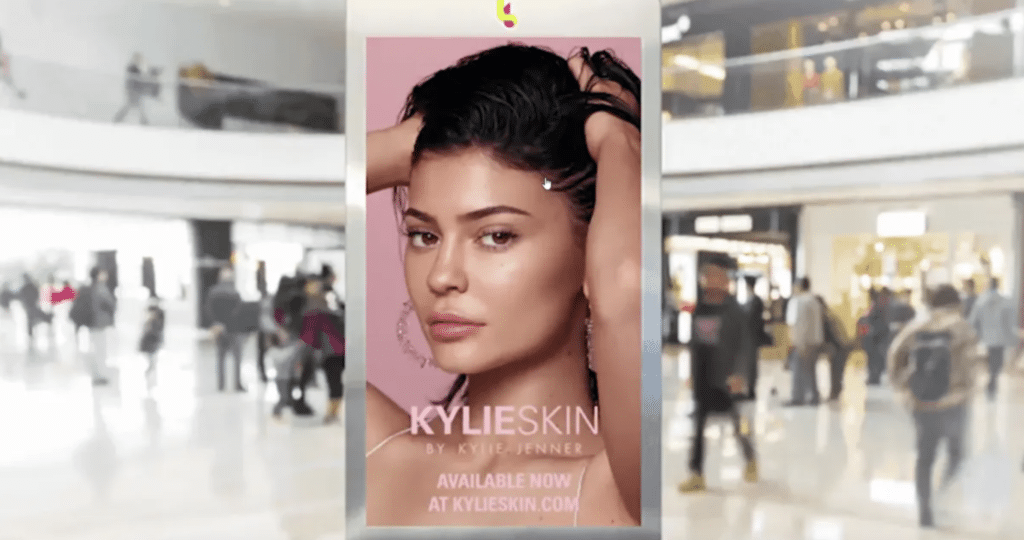
This drove purchase intent, and her product was sold out within hours, generating excitement on social media.
7. Disneyland: Movie Theater DOOH Ads
The “Show Your Disney Side” initiative from Disneyland used the power of DOOH to turn an ordinary shopping mall stroll into something enchanting.
Disney’s crew built an imitation storefront and set the stage for silhouettes of well-loved characters to appear. Unwitting shoppers were surprised as shadows of Disney characters materialized behind them while they walked.
This creative cinema advertising campaign garnered more than 300 million views and 5.9 million global shares, thus earning the distinction of being the 2nd most shared commercial in 2015.
The Future of Digital Out-of-Home is Programmatic
Digital OOH advertising’s traditional, slow process burdened small teams and obscured success due to a lack of real-time analytics and delays. Programmatic DOOH (pDOOH) revolutionizes this by:
- Automating inventory purchase, similar to current online advertising space buying.
- Removing intermediaries for quicker processes and real-time analytics.
Media buyers can now dictate when and where their ads are displayed, whether on specific days, traffic levels, external conditions, or internal metrics (e.g., a museum advertising only when ticket sales are low). This enables nuanced targeting based on audience receptiveness. Unlike traditional OOH focused on reach, programmatic DOOH introduces real-time analytics and audience targeting into the outdoor advertising landscape.
⚡ US programmatic digital-out-of-home is expected to grow from $660 million to $1.11 billion between 2023 and 2025.
The National CineMedia Plans to Go Programmatic In Movie Theaters
Also, the National CineMedia (NCM) is set to start selling programmatic movie screen advertising in Q4, turning cinema screens into a performance channel to appeal to digital advertisers.
Operating in 1,500 US theaters and reaching around 20,000 movie screens, NCM has rich First-Party data obtained through online ticket sales and loyalty memberships, supplemented by online retargeting via partnerships with publishers like YouTube and Yahoo.
👀 A study by Lumen using eye-tracking technology revealed that 97% of moviegoers watch the big screen during ads, compared to only 35% of TV viewers.
The development, unique in targeting a mass audience, uses programmatic ad buying to engage hard-to-reach audiences and possibly revolutionize ad delivery for cinema advertising.
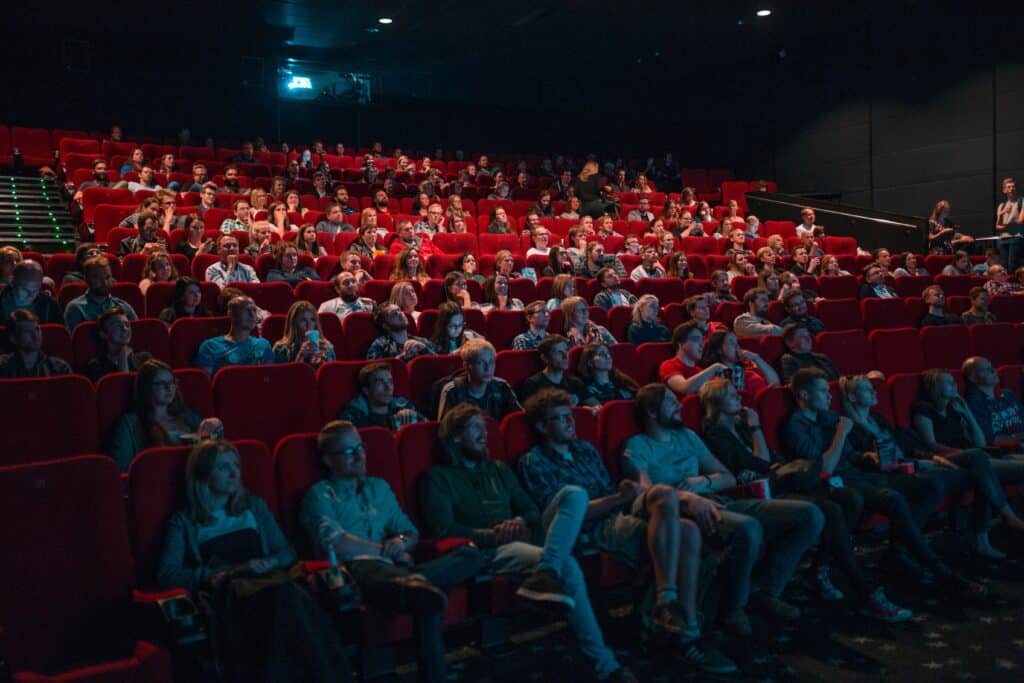
Get Started with Programmatic DOOH Today
Programmatic Digital Out-Of-Home solutions break the barriers between brands, campaigns, and consumers by making the boundaries between the digital and physical worlds a thing of the past.
pDOOH is a digital solution that transforms how brands reach consumers by making their ads more interactive and relevant.
When pDOOH began, it was strictly a visual display of out-of-home campaigns. Now, it uses advanced targeting capabilities, real-time optimization, and high-precision targeting to maximize the impact of outdoor advertising.
With the integration of beacon technology, mobile data providers, and trigger-based buying campaigns, programmatic DOOH offers enhanced audience engagement and improved attribution reporting, making it a valuable advertising medium for reaching diverse audiences in shopping malls, airports, and other outdoor locations.
🔎 Your customers are people, not just data points.
Let us help you find them.
Connect with our expert strategists and receive customized, customer-centric solutions that cater to your budget.
About the Author
Paola Miano is a Blue Heeler lover who spends most of her weekends training her dog or pumping up the crowd at karaoke.
